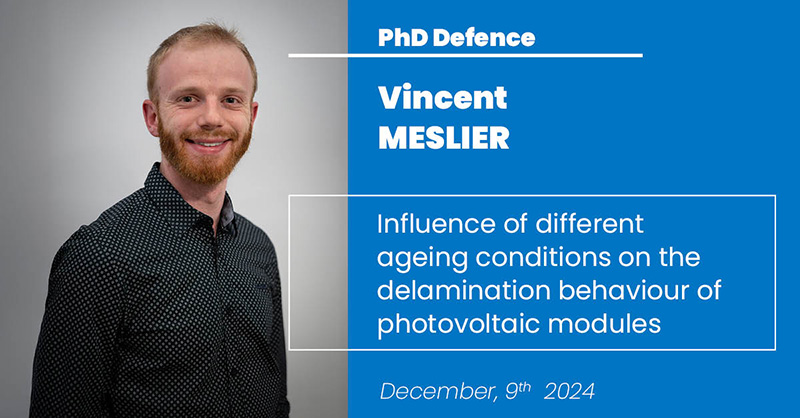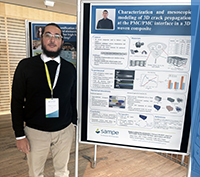PhD Defence of Vincent Meslier
Influence of different ageing conditions on the delamination behaviour of photovoltaic modules

Vincent Meslier conducted his PhD research in the CSM and S&P research teams, under the supervision of Pierre-Olivier Bouchard and Jean-Luc Bouvard in the framework of project with the CEA. He will defend his PhD in Computational Mechanics and Materials on December 9th, 2024, in front of the following jury:
Mme Julie DIANI Ecole Polytechnique Reviewer
M. Bruno FAYOLLE Arts et Métiers Paris Reviewer
M. Etienne BARTHEL ESPCI Paris
M. Matthieu DESPEISSE CSEM
M. Bertrand CHAMBION CEA Grenoble INES
M. Pierre-Olivier BOUCHARD Mines Paris PSL
M. Jean-Luc BOUVARD Mines Paris PSL
Abstract:
Delamination is considered as the largest long-term degradation mechanism for photovoltaic (PV) modules. In order to gain a deeper understanding and to characterise these delamination issues, this thesis work focuses on the ageing behaviour of a thermoplastic polyolefin (TPO) through an hybrid experimental-numerical approach. Evaluated through different ageing conditions, the viscoelasticity, hyperelasticity, thermal expansion and adhesion with glass properties are investigated. Microstructure changes are also followed over ageing to explain the mechanical properties observations. Ageing conditions are achieved in a controlled environment to develop degradation models based on ageing factors such as humidity, temperature and ultra-violet radiations. These controlled degradations are then compared with the results of natural degradation performed at INES in Le Bourget-du-lac, France. Concurrently to these experimental investigations, two numerical models are developed in Abaqus®. The first one aims at reproducing the 180° peeling test used to assess experimentally the adhesion at the TPO/glass interface. TPO is considered as a visco-hyper-elastic material and adhesion is modelled by a Cohesive Zone Model (CZM) whose parameters are identified by inverse analysis. The interface properties are then transferred to another numerical model aiming at describing the mechanical behaviour of an aged PV module during thermal cycling tests. Preferential delamination sites of PV modules are identified both in space and time during a thermal cycling test. The outcomes of this study provide valuable scientific and technical insights for improving future generations of PV modules reliability. To our knowledge, this is the first model that incorporates the polymers aged properties into the numerical simulation of a PV module.
Keywords: photovoltaic, reliability, material mechanics, polymer, numerical simulation, ageing








